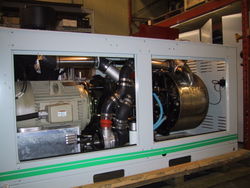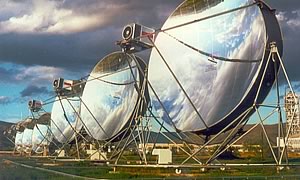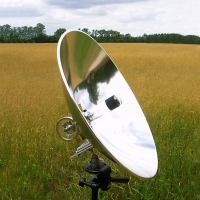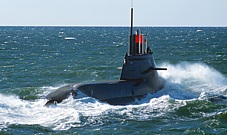|
Power plants on the electric grid use fuel to produce electricity, however there are large quantities of waste-heat produced which often go unused. In other situations, high-grade fuel is  burned at high-temperature for a low-temperature application. According to the second law of thermodynamics, a heat engine can generate power from this temperature difference. In a CHP system, the high-temperature primary heat enters the Stirling engine heater, then some of the energy is converted to mechanical power in the engine, and the rest passes through to the cooler, where it exits at a low temperature. The "waste" heat actually comes from engine's main cooler, and possibly from other sources such as the exhaust of the burner, if there is one. burned at high-temperature for a low-temperature application. According to the second law of thermodynamics, a heat engine can generate power from this temperature difference. In a CHP system, the high-temperature primary heat enters the Stirling engine heater, then some of the energy is converted to mechanical power in the engine, and the rest passes through to the cooler, where it exits at a low temperature. The "waste" heat actually comes from engine's main cooler, and possibly from other sources such as the exhaust of the burner, if there is one.
In a combined heat and power (CHP) system, mechanical or electrical power is generated in the usual way, however, the waste heat given off by the engine is used to supply a secondary heating application. This can be virtually anything that uses low-temperature heat. It is often a pre-existing energy use, such as commercial space heating, residential water heating, or an industrial process.
CHP does not increase efficiency according to the first law of thermodynamics (conservation of energy), nor does it violate that law, but rather, CHP operates closer to the efficiency limit allowed by the second law.
The power produced by the engine can be used to run an industrial or agricultural process, which in turn creates biomass waste refuse that can be used as free fuel for the engine, thus reducing waste removal costs. The overall process is very resourceful, thus making it efficient and cost-effective overall.
WhisperGen, a New Zealand firm with offices in Christchurch, has developed an "AC Micro Combined Heat and Power" Stirling cycle engine. These microCHP units are gas-fired central heating boilers which sell unused power back into the electricity grid. WhisperGen announced in 2004 that they were producing 80,000 units for the residential market in the United Kingdom. A 20 unit trial in Germany started in 2006.
Solar power generation
 Placed at the focus of a parabolic mirror a Stirling engine can convert solar energy to electricity with an efficiency better than non-concentrated photovoltaic cells, and comparable to Placed at the focus of a parabolic mirror a Stirling engine can convert solar energy to electricity with an efficiency better than non-concentrated photovoltaic cells, and comparable to  Concentrated Photo Voltaics. On August 11, 2005, Southern California Edison announced an agreement to purchase solar powered Stirling engines from Stirling Energy Systems over a twenty year period and in quantity (20,000 units) sufficient to generate 500 megawatts of electricity. These systems, on a 4,500 acre (19 km²) solar farm, will use mirrors to direct and concentrate sunlight onto the engines which will in turn drive generators. Concentrated Photo Voltaics. On August 11, 2005, Southern California Edison announced an agreement to purchase solar powered Stirling engines from Stirling Energy Systems over a twenty year period and in quantity (20,000 units) sufficient to generate 500 megawatts of electricity. These systems, on a 4,500 acre (19 km²) solar farm, will use mirrors to direct and concentrate sunlight onto the engines which will in turn drive generators.
Stirling cryocoolers
Any Stirling engine will also work in reverse as a heat pump: i.e. when a motion is applied to the shaft, a temperature difference appears between the reservoirs. The essential mechanical components of a Stirling cryocooler are identical to a Stirling engine. In both the engine and the heat pump, heat flows from the expansion space to the compression space; however, input work is required in order for heat to flow against a thermal gradient, specifically when the compression space is hotter than the expansion space. The external side of the expansion-space heat-exchanger may be placed inside a thermally insulated compartment such as a vacuum flask. Heat is in effect pumped out of this compartment, through the working gas of the cryocooler and into the compression space. The compression space will be above ambient temperature, and so heat will flow out into the environment.
One of their modern uses is in cryogenics, and to a lesser extent, refrigeration. At typical refrigeration temperatures, Stirling coolers are generally not economically competitive with the less expensive mainstream Rankine cooling systems, even though they are typically 20% more energy efficient. However, below about -40 to -30 deg.C, Rankine is not effective because there are no suitable refrigerants with boiling points this low. Stirling cryocoolers are able to "lift" heat down to -200 deg.C (73 K), which is sufficient to liquefy air (oxygen, nitrogen and argon). They can go as low as 60K - 40K, depending on the particular design. Cryocoolers for this purpose are more-or-less competitive with other cryocooler technologies. The coefficient of performance at cryogenic temperatures is typically 4-5%.[1] Empirically, the devices show a linear trend, where typically the COP = 0.0015 × Tc - 0.065 , where Tc is the cryogenic temperature. At these temperatures, solid materials have lower values for specific heat, so the regenerator must be made out of unexpected materials, such as cotton.
The first Stirling-cycle cryocooler was developed at Philips in the 1950s and commercialized in such places as liquid air production plants. The Philips Cryogenics business evolved until it was split off in 1990 to form the Stirling Cryogenics & Refrigeration BV, The Netherlands. This company is still active in the development and manufacturing of Stirling cryocoolers and cryogenic cooling systems.
A wide variety of smaller size Stirling cryocoolers are commercially available for tasks such as the cooling of electronic sensors and sometimes microprocessors. For this application, Stirling cryocoolers are the highest performance technology available, due to their ability to lift heat efficiently at very low temperatures. They are silent, vibration-free, and can be scaled down to small sizes, and have very high reliability and low maintenance. As of 2008, cryocoolers are considered to be the only commercially successful Stirling devices.
Thermoacoustic refrigeration devices are very different than Stirling devices, although the individual path traveled by each working gas molecule is a Stirling cycle. High-amplitude acoustic standing waves cause compression and expansion analogous to a Stirling power piston, while out-of-phase acoustic traveling waves cause displacement along a temperature gradient, analogous to a Stirling displacer piston.
Heat pump
A Stirling heat pump is very similar to a Stirling cryocooler, the main difference being that it usually operates at room-temperature and its principal application to date is to pump heat from the outside of a building to the inside, thus cheaply heating it.
As with any other Stirling device, heat flows from the expansion space to the compression space; however, in contrast to the Stirling engine, the expansion space is at a lower temperature than the compression space, so instead of producing work, an input of mechanical work is required by the system (in order to satisfy the second law of thermodynamics). When the mechanical work for the heat-pump is provided by a second Stirling engine, then the overall system is called a "heat-driven, heat-pump".
The expansion-side of the heat-pump is thermally coupled to the heat-source, which is often the external environment. The compression side of the Stirling device is placed in the environment to be heated, for example a building, and heat is "pumped" into it. Typically there will be thermal insulation between the two sides so there will be a temperature rise inside the insulated space.
Heat-pumps are by far the most energy-efficient types of heating systems. Stirling heat-pumps also often have a higher coefficient of performance than conventional heat-pumps. To date, these systems have seen limited commercial use; however, use is expected to increase along with market demand for energy conservation, and adoption will likely be accelerated by technological refinements.
 Marine engines Marine engines
Kockums, the Swedish shipbuilder, had built at least 8 commercially successful Stirling powered submarines during the 1980s. As of 2005 they have started to carry compressed oxygen with them (see Gotland class submarine). With their air-independent propulsion systems such as fuel cell or Stirling, they stay submerged much longer than conventional submarines.
Nuclear Power
There is a potential for nuclear-powered Stirling engines in electric power generation plants. Replacing the steam turbines of nuclear power plants with Stirling engines might simplify the plant, yield greater efficiency, and reduce the radioactive by-products. A number of breeder reactor designs use liquid sodium as coolant. If the heat is to be employed in a steam plant, a water/sodium heat exchanger is required, which raises some concern as sodium reacts violently with water. A Stirling engine obviates the need for water anywhere in the cycle.
United States government labs have developed a modern Stirling engine design known as the Stirling Radioisotope Generator for use in space exploration. It is designed to generate electricity for deep space probes on missions lasting decades. The engine uses a single displacer to reduce moving parts and uses high energy acoustics to transfer energy. The heat source is a dry solid nuclear fuel slug and the heat sink is space itself.
Automotive engines
It is often claimed that the Stirling engine has too low a power/weight ratio and too long a starting time for automotive applications. They also have complex and expensive heat-exchangers that must be made of stainless steel, and do not scale-up well to 100 kW output power. There have been at least two automobiles exclusively powered by Stirling engines that were developed by NASA, as well as earlier projects by Ford and American Motor Companies.
The main difficulties involved in using the Stirling engine in an automotive application are start-up time, acceleration response, shut-down time, and weight, not all of which have ready-made solutions. Many people believe that hybrid electric drive systems can bypass all of these setbacks. In November 2007, a prototype hybrid car using solid bio-fuel and a Stirling engine was announced by the Precer project in Sweden. www.precer.se (in Swedish, with an English specification sheet under the PDF link).
The NASA vehicles were designed by contractors and designated MOD I and MOD II. The MOD II replaced the normal spark-ignition engine in a 1985 4-door Chevrolet Celebrity hatchback. In the 1986 MOD II Design Report (Appendix A) the results show that the highway gas mileage was increased from 40 to 58 mpg and the urban mileage from 26 to 33 mpg with no change in gross weight of the vehicle.
Start-up time in the NASA vehicle maxed out at 30 seconds, while Ford's research vehicle used an electric heater placed directly into the hot air mix to get the vehicle started in only a few seconds.
Geothermal energy
Some believe that the ability of the Stirling engine to convert geothermal energy to electricity and then to hydrogen may well hold the key to replacement of fossil fuels in a future hydrogen economy. This belief was also founded on research conducted at Los Alamos Labs that began as a hot dry rocks research, but later calculated the near limitless energy potential from molten rock on one side of a Stirling engine and ocean water on the other. Although currently the most feasible source of commercial electrical generation is solar, very long range predictions show advances in deep drilling and development of methods to work with molten rock could yield exponential levels of clean energy generation for thousands of years.
Low temperature difference engines
A low temperature difference (Low Delta T, or LTD) Stirling engine will run on any low temperature differential, for example the difference between the palm of a hand and room-temperature or room temperature and an ice cube. Usually they are designed in a gamma configuration, for simplicity, and without a regenerator. They are typically unpressurized, running at near-atmospheric pressure. The power produced is less than one watt, and they are intended for demonstration purposes only. They are perfect as educational models.
For example see the
Stirlingvideo from our Low Temperature Stirling engine GT02.
|
 burned at high-temperature for a low-temperature application. According to the second law of thermodynamics, a heat engine can generate power from this temperature difference. In a CHP system, the high-temperature primary heat enters the Stirling engine heater, then some of the energy is converted to mechanical power in the engine, and the rest passes through to the cooler, where it exits at a low temperature. The "waste" heat actually comes from engine's main cooler, and possibly from other sources such as the exhaust of the burner, if there is one.
burned at high-temperature for a low-temperature application. According to the second law of thermodynamics, a heat engine can generate power from this temperature difference. In a CHP system, the high-temperature primary heat enters the Stirling engine heater, then some of the energy is converted to mechanical power in the engine, and the rest passes through to the cooler, where it exits at a low temperature. The "waste" heat actually comes from engine's main cooler, and possibly from other sources such as the exhaust of the burner, if there is one. Placed at the focus of a parabolic mirror a Stirling engine can convert solar energy to electricity with an efficiency better than non-concentrated photovoltaic cells, and comparable to
Placed at the focus of a parabolic mirror a Stirling engine can convert solar energy to electricity with an efficiency better than non-concentrated photovoltaic cells, and comparable to 
 Marine engines
Marine engines